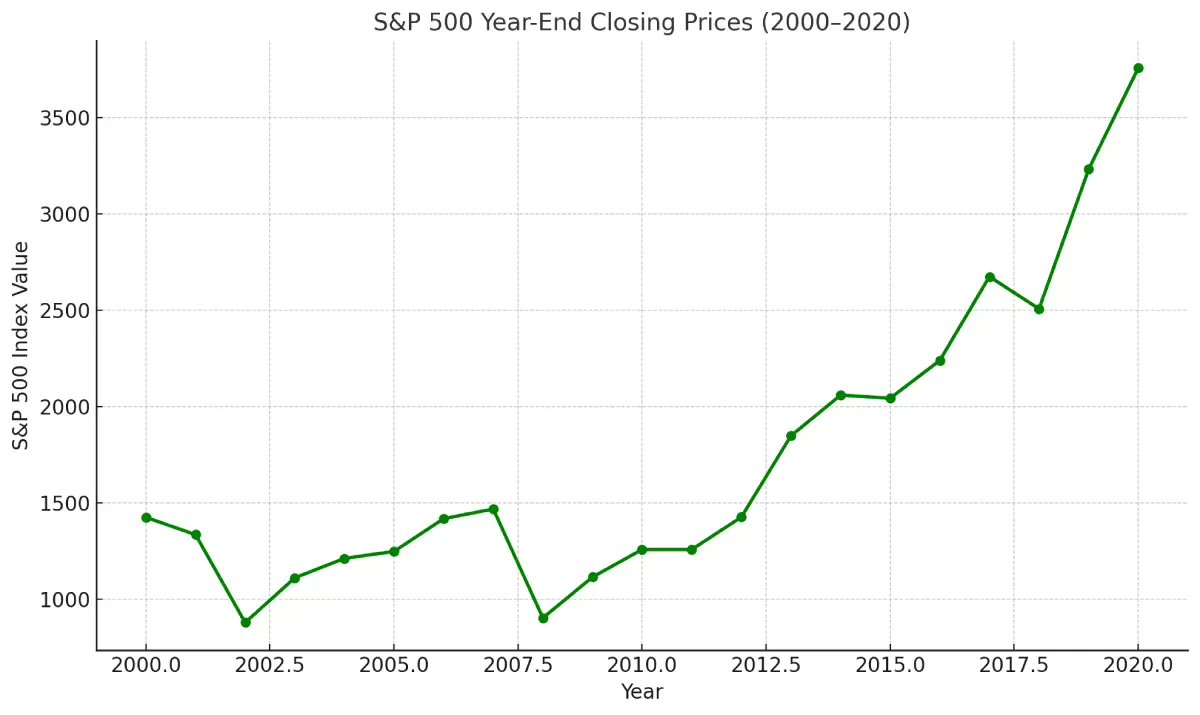Key Takeaways
- Long-term investing helps you ride out market volatility and recover from downturns.
- Compounding returns and lower taxes make long-term investing more rewarding.
- Staying invested reduces emotional decisions and improves overall portfolio performance.
Why Long-Term Thinking Beats Market Timing
Trying to time the market—buying low and selling high—might sound like a winning strategy, but in reality, it’s incredibly difficult to do consistently. Many investors fall into the trap of reacting emotionally to short-term market movements, chasing quick profits during rallies or selling in fear when prices dip. Unfortunately, this often leads to buying high and selling low—the opposite of what successful investing requires.
Long-term investing, on the other hand, is built on patience and perspective. By staying invested in strong companies or broad indices like the S&P 500 over time, you give your money the chance to grow through the natural ups and downs of the market. Temporary volatility becomes less threatening when you zoom out and focus on the bigger picture.
History has repeatedly shown that investors who hold their positions through market cycles—whether during recessions, pandemics, or geopolitical events—tend to come out ahead. Time in the market consistently beats timing the market. This article explores the reasons why long-term investing is such a powerful strategy, how it helps you avoid costly mistakes, and what you can do to start applying it to your own portfolio.
Better Long-Term Returns
One of the strongest arguments for long-term investing is its consistent ability to deliver solid returns over time. While market volatility can be unsettling in the short term, holding quality assets—such as a broad-market index like the S&P 500—has historically proven to be one of the most reliable ways to build wealth.
Let’s look at the numbers: Over the past 90 years, the S&P 500 has delivered an average annual return of around 10%. That includes wars, recessions, political shifts, inflation spikes, and even global pandemics. Despite all that turbulence, the long-term trend has remained upward.
Even more compelling, nearly every 20-year period in the S&P 500’s history has ended in positive returns, no matter when you started investing. This means that time, not timing, is what truly matters. Investors who try to guess the best moments to buy and sell often miss key opportunities—whereas those who stay the course give their investments the chance to benefit from market recoveries and compounding growth.
Historical Performance: The 2008 Financial Crisis
Take the 2008 financial crisis as an example. It was one of the worst market downturns in modern history, and many investors understandably panicked. Those who sold their stocks at the bottom locked in their losses—and missed out on the powerful rebound that followed.
But investors who remained invested from 2008 through 2020 experienced extraordinary gains. In fact, the S&P 500 more than tripled in value during that period. This kind of performance highlights the importance of riding out downturns instead of reacting to fear.
Long-term investing isn’t about avoiding losses—it’s about allowing time and resilience to work in your favor. The key is to choose quality investments, stay consistent, and resist the urge to make short-term decisions based on emotions or headlines.

Think Like a Roller Coaster Rider
The stock market can sometimes feel like a wild ride—full of sudden drops, sharp turns, and unexpected highs. And just like a roller coaster, it’s easy to feel nervous when the descent begins. But here’s the thing: those dips are often followed by strong upward moves. The key is learning not to jump off the ride when it gets shaky.
Short-term market drops are normal. In fact, they’re a natural part of how the market functions. Prices move up and down in response to news, earnings reports, economic indicators, and even investor sentiment. While this volatility can feel unsettling, it doesn’t mean your investments are on the wrong track. Historically, markets have always recovered—and then gone on to reach new highs.
That’s why long-term investors have a major advantage: they don’t need to worry about every daily price swing. Instead of checking the market every hour and reacting emotionally, they stay focused on their goals, confident that time and growth will do the heavy lifting. In contrast, short-term emotional decisions—like panic selling during a downturn—often result in locking in losses and missing the eventual rebound.
A Helpful Analogy: Investing Is Like Planting a Tree
Think of investing like planting a tree. When you first plant it, you don’t expect it to grow overnight. You water it, give it sunlight, and trust the process. You don’t dig it up every day to see if it’s grown—you let time do its work. In the same way, long-term investing is about patience and nurturing. You may not see big changes daily, but over the years, that investment can grow into something significant.
By accepting that ups and downs are part of the journey, and by staying focused on the long-term trend, you can avoid costly mistakes and build a stronger, more resilient portfolio. It’s not about being fearless—it’s about being committed.
The Hidden Advantage: Tax Benefits of Holding Long-Term
One of the most overlooked—but incredibly valuable—benefits of long-term investing is how it can reduce your tax bill. When you buy and sell assets like stocks or ETFs, the government taxes your gains—but how much you pay depends on how long you held the investment.
If you sell an asset you’ve held for less than a year, your profits are considered short-term capital gains. These are taxed at the same rate as your regular income, which can be as high as 37%, depending on your tax bracket. That’s a big bite out of your earnings.
However, if you hold that same asset for more than one year before selling, your profit is taxed as a long-term capital gain, and the rate drops significantly—usually between 0% and 20%, depending on your income level. For many investors, this can mean keeping thousands more in profit simply by being patient.
This tax difference alone can dramatically improve your net returns over time, especially when compounded year after year. It’s a smart way to grow your portfolio more efficiently, without needing to take on extra risk.
Pro Tip: Let Time Work for You—Tax Efficiently
Want to take things a step further? Consider using tax-advantaged accounts like Roth IRAs, Traditional IRAs, or 401(k)s, where gains can grow tax-deferred or even tax-free, depending on the account type. These vehicles are especially powerful for long-term investors because they allow you to build wealth while keeping Uncle Sam out of your pocket (for now—or forever, in the case of Roth accounts).
You can also work with a financial advisor or tax planner to build a strategy that aligns with your income level and investment goals—so you’re not just growing wealth, you’re keeping more of it.
The Hidden Advantage: Tax Benefits of Holding Long-Term
One of the most overlooked—but incredibly valuable—benefits of long-term investing is how it can reduce your tax bill. When you buy and sell assets like stocks or ETFs, the government taxes your gains—but how much you pay depends on how long you held the investment.
If you sell an asset you’ve held for less than a year, your profits are considered short-term capital gains. These are taxed at the same rate as your regular income, which can be as high as 37%, depending on your tax bracket. That’s a big bite out of your earnings.
However, if you hold that same asset for more than one year before selling, your profit is taxed as a long-term capital gain, and the rate drops significantly—usually between 0% and 20%, depending on your income level. For many investors, this can mean keeping thousands more in profit simply by being patient.
This tax difference alone can dramatically improve your net returns over time, especially when compounded year after year. It’s a smart way to grow your portfolio more efficiently, without needing to take on extra risk.
Pro Tip: Let Time Work for You—Tax Efficiently
Want to take things a step further? Consider using tax-advantaged accounts like Roth IRAs, Traditional IRAs, or 401(k)s, where gains can grow tax-deferred or even tax-free, depending on the account type. These vehicles are especially powerful for long-term investors because they allow you to build wealth while keeping Uncle Sam out of your pocket (for now—or forever, in the case of Roth accounts).
You can also work with a financial advisor or tax planner to build a strategy that aligns with your income level and investment goals—so you’re not just growing wealth, you’re keeping more of it.
Frequently Asked Questions
Q: Isn’t long-term investing risky?
A: It’s a great question—and one that many new investors ask. The truth is, all investing involves some level of risk, whether you’re in the market for a day or a decade. Prices can fluctuate due to economic news, earnings reports, interest rates, and even global events. However, long-term investing actually helps reduce risk over time.
Why? Because the longer you stay invested—especially in a well-diversified portfolio—the more likely you are to ride out short-term volatility and benefit from the market’s natural tendency to grow. Diversifying your investments across different sectors, industries, and asset types is like spreading your eggs across many baskets. That way, if one sector underperforms, others may help balance things out.
In fact, historical data shows that the likelihood of losing money goes down the longer you stay invested—especially when you’re invested in broad market indices like the S&P 500.
Q: What if I need the money soon?
A: That’s a smart consideration, and it’s where investment planning meets real life. Long-term investing works best with money you won’t need for several years—think retirement savings, a child’s college fund, or long-term wealth-building goals.
If you know you’ll need access to your money soon—within the next few months or even a year or two—it’s usually better to keep those funds in safer, more liquid places, like a high-yield savings account, a money market fund, or short-term bonds. These options won’t deliver the same returns as stocks, but they offer stability and quick access without the risk of sudden loss.
A helpful rule of thumb:
- Short-term money = low-risk, easy-access options.
- Long-term money = growth-focused investments like stocks and ETFs.
By separating your savings into short- and long-term buckets, you can protect your financial stability now while allowing your investments to grow for the future.
Build Wealth Without Stress
Let’s face it—constantly checking stock prices, reacting to headlines, and trying to predict the next market move can be exhausting. That kind of short-term thinking often leads to stress, emotional decisions, and missed opportunities. But here’s the good news: there’s a better, calmer way to build wealth.
Long-term investing offers a clear advantage. By committing to a strategy and letting it play out over time, you reduce the number of decisions you have to make and the emotional rollercoaster that often comes with daily market watching. You’re no longer worrying about what the market did today—you’re focused on where your investments will be years from now.
More importantly, long-term investing allows you to harness the incredible power of compound growth—where your gains start earning gains of their own. The longer you stay invested, the more this snowball effect works in your favor. It’s like planting seeds and watching a forest grow—slow at first, but unstoppable over time.
The key is to start with a plan:
- Clarify your financial goals (retirement, buying a home, building a legacy).
- Choose a diversified investment strategy that fits your risk tolerance and time horizon.
- Stick with it, even when markets get noisy.
Long-term investors aren’t trying to be perfect. They’re focused on being consistent—and that makes all the difference. With patience, discipline, and time on your side, you can build real wealth—without the daily stress.
The Bottom Line
When it comes to building lasting wealth, long-term investing stands out as one of the most effective and reliable strategies. It’s not about picking the next big stock or timing the perfect entry—it’s about staying invested, staying patient, and trusting the process.
The beauty of long-term investing lies in its simplicity: you choose quality assets, give them time to grow, and let compound returns do the heavy lifting. It doesn’t require constant monitoring, complex tactics, or reacting to every headline. In fact, the less you tinker, the better your chances of success.
Yes, there will be ups and downs. Markets will fluctuate, and there may be times when it feels tempting to make quick changes. But if you stick with your plan and keep your long-term goals in focus, you’re far more likely to come out ahead.
So whether you’re saving for retirement, your child’s education, or just aiming for financial independence, remember: consistency beats intensity. Small, steady steps taken over time can lead to truly life-changing results.








